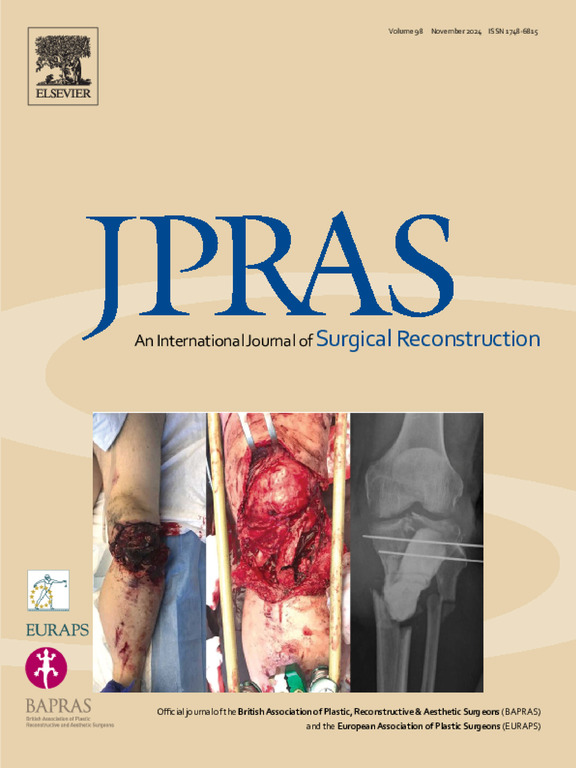Risk of myocardial infarction and stroke in patients with keloids: A nationwide population-based cohort study
IF 2
3区 医学
Q2 SURGERY
Journal of Plastic Reconstructive and Aesthetic Surgery
Pub Date : 2025-03-17
DOI:10.1016/j.bjps.2025.03.034
引用次数: 0
Abstract
Background
Keloids represent a form of benign fibroproliferative disorder. Prior studies have linked various fibroproliferative conditions to an increased cardiovascular disease risk; however, the relationship between keloids and major adverse cardiovascular events, such as myocardial infarction (MI) and stroke, remains inadequately explored. A comprehensive nationwide population-based cohort approach was used to examine the cardiovascular disease risk in patients with keloids.
Methods
The cohort comprised 554,501 patients with keloid and 1,109,002 matched controls. Primary measures included the incidence rates and incidence rate ratios of MI, ischemic stroke (IS), and hemorrhagic stroke (HS) compared to the matched controls. The study applied a stratified Cox regression hazard model to compute the relative hazards between patients with keloid and the controls.
Results
Incidence rate ratios for cardiovascular diseases in patients with keloid, relative to controls, were 1.08 (95% confidence interval [CI], 1.06–1.10) for MI, 1.06 (CI, 1.04–1.08) for IS, and 1.05 (CI, 1.01–1.08) for HS. After adjusting for additional cardiovascular risk factors, a persistent elevated risk for MI and IS was evident in patients with keloid with adjusted hazard ratios (HRs) of 1.04 (CI 1.01–1.07) for MI and 1.03 (CI 1.00–1.07) for IS. Stratified analyses by age, sex, body mass index, and smoking status revealed consistent risk elevations in older individuals (≥50 years), women, obese individuals, and nonsmokers.
Conclusions
Keloids are associated with a significant increase in MI and IS risk, independent of the traditional cardiovascular risk factors. This association is particularly prominent in older adults, women, obese individuals, and nonsmokers.
瘢痕疙瘩患者心肌梗死和卒中的风险:一项基于全国人群的队列研究
瘢痕疙瘩是一种良性纤维增生性疾病。先前的研究已将各种纤维增生性疾病与心血管疾病风险增加联系起来;然而,瘢痕疙瘩与主要不良心血管事件(如心肌梗死(MI)和中风)之间的关系仍未得到充分探讨。一项全面的基于全国人群的队列方法被用于检查瘢痕疙瘩患者的心血管疾病风险。方法该队列包括554,501例瘢痕疙瘩患者和1,109,002例匹配对照。主要测量指标包括心肌梗死、缺血性卒中(IS)和出血性卒中(HS)的发生率和发病率比。本研究采用分层Cox回归风险模型计算瘢痕疙瘩患者与对照组之间的相对风险。结果瘢痕疙瘩患者心血管疾病的发病率与对照组相比,心肌梗死为1.08(95%可信区间[CI], 1.06 - 1.10), IS为1.06(95%可信区间[CI], 1.04-1.08), HS为1.05(95%可信区间[CI], 1.01-1.08)。在校正了其他心血管危险因素后,瘢痕疙瘩患者发生心肌梗死和IS的风险持续升高,心肌梗死的调整危险比(hr)为1.04 (CI 1.01-1.07), IS的调整危险比(hr)为1.03 (CI 1.00-1.07)。按年龄、性别、体重指数和吸烟状况进行的分层分析显示,老年人(≥50岁)、女性、肥胖者和非吸烟者的风险升高一致。结论类固醇与心肌梗死和IS风险显著增加相关,独立于传统的心血管危险因素。这种关联在老年人、女性、肥胖者和非吸烟者中尤为突出。
本文章由计算机程序翻译,如有差异,请以英文原文为准。
求助全文
约1分钟内获得全文
求助全文
来源期刊
CiteScore
3.10
自引率
11.10%
发文量
578
审稿时长
3.5 months
期刊介绍:
JPRAS An International Journal of Surgical Reconstruction is one of the world''s leading international journals, covering all the reconstructive and aesthetic aspects of plastic surgery.
The journal presents the latest surgical procedures with audit and outcome studies of new and established techniques in plastic surgery including: cleft lip and palate and other heads and neck surgery, hand surgery, lower limb trauma, burns, skin cancer, breast surgery and aesthetic surgery.

 求助内容:
求助内容: 应助结果提醒方式:
应助结果提醒方式:


